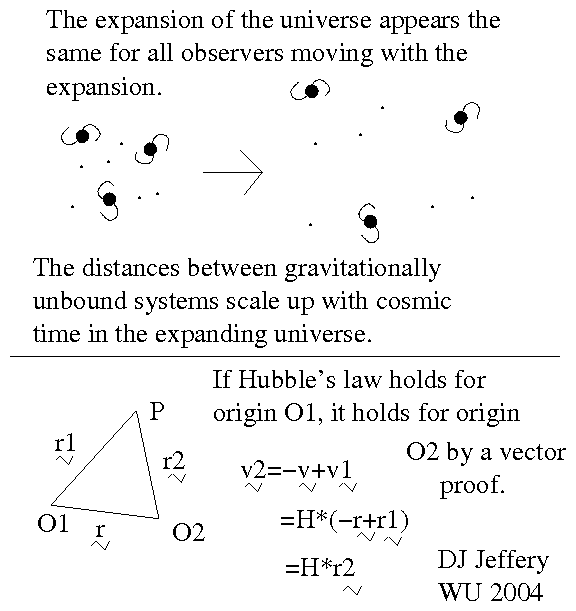
Caption: The expansion of the universe is general, uniform scaling up of gravitationally unbound systems ---it's everywhere---everywhere we can see that is: i.e., the observable universe. There is NO center of expansion and nothing is being expanded into as far as we can see in the observable universe.
Features:
-
Note, systems like you, me,
moons,
planets,
stars,
galaxies, and
probably most galaxy clusters
are NOT expanding.
These are all bound systems:
gravitationally bound
or (like you and me) bound by the
electromagnetic force and
the strong nuclear force.
- The scaling up is between
bound systems.
General relativity (GR) along with other assumptions predicts the expansion of the universe. GR tells us the expansion is a literal growth of space---space is a kind of stuff/structure that can grow or shrink.
- The points that participate in the
mean expansion of the universe
define fundamental
free-fall frames
(which are exact
inertial frames)
in our modern understanding of
cosmology.
The comoving frames, in fact, form a continuum of fundamental free-fall frames throughout the observable universe.
-
This modern theory of
comoving frames
replaced
the theory of
absolute space
of Isaac Newton (1643--1727).
He hypothesized that the reference frame in which the fixed stars were on average at rest was the singular fundamental inertial frame which he called absolute space. All other exact inertial frames were unaccelerated relative to absolute space.
- Comoving frames
can actually be identified by
astronomical observations.
The barycenters
(i.e., centers of mass)
of most
galaxy clusters
and field galaxies
(those NOT in galaxy clusters)
and the reference frames that move with them
are approximately
comoving frames---this
hypothesis is verified
by the consistency of all modern cosmology.
This means we can then calculate the internal motions of galaxy clusters and field galaxies using Newtonian physics for the most part.
For the observable universe as whole, we are beyond the realm of validity of using a single inertial frame and must use general relativity in a more direct sense.
- What if the observable universe
is exactly like the rest of the whole
universe?
Well it may be then that the universe is infinite and getting bigger.
Or it may be that the universe is a finite hypersphere---a 4-dimensional sphere with a curved 3-dimensional surface, but with the curvature so small we have NOT detected it---we may be microbes on a billard ball.
- On the other hand, maybe well beyond the
observable universe, there
are other regions where different conditions obtain.
We do NOT know, but there are many theories.
The multiverse paradigm is one huge cluster of such theories. The usual idea is that there is a background false-vacuum universe full of pocket universes in which different conditions and even different physical laws hold. The observable universe is embedded so deeply in our pocket universe that we do NOT see any trace of its boundaries.
- To measure
translational motion
relative to the
local
comoving frame,
you measure the
CMB dipole anisotropy.
For an explication, see the figure at
/homes/jeffery/web/astro/cosmol/cmb_dipole_anisotropy.html.
Image link: Itself.
Local file: local link: expanding_universe.html.
File: Cosmology file: expanding_universe.html.